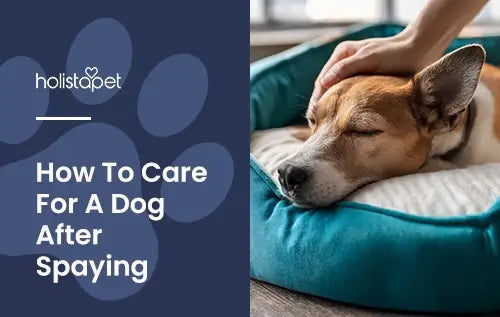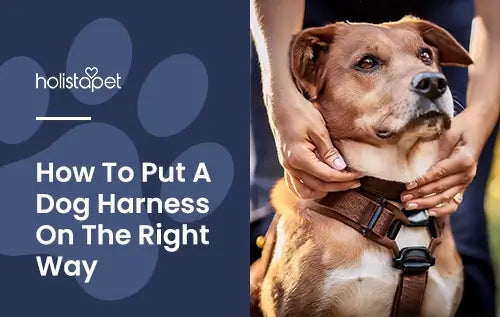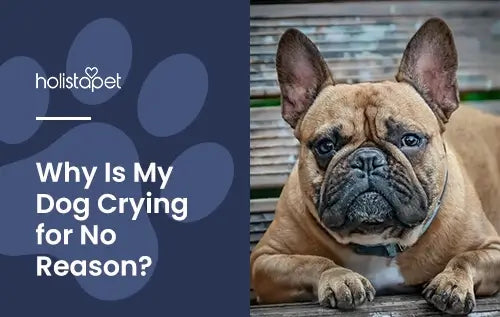Your pup deserves the royal treatment after their spay procedure, and proper dog spay recovery is the secret to a smooth healing journey. From cozy cuddle sessions to thoughtful post-surgical routines, helping your furry friend bounce back can be simple and stress-free.
This guide offers tips and tricks for keeping your beloved pet happy, healthy, and back to their peppy self quickly. Let's begin.
What To Expect After Your Dog's Spay Surgery

You can expect a few changes in your pet's behavior and routine after their spay surgery. The recovery process varies for each pup, but with patience and the right post-op care, your canine companion will be fully healed in no time. But first, what is spaying or neutering anyway?
Spaying and neutering are common procedures that help control the pet population and improve the overall health of our furry friends. These surgeries are routine and typically performed by a skilled veterinary team.
Spaying, performed on female dogs, involves the surgical removal of the ovaries and uterus. This prevents heat cycles and the risk of certain health issues. Meanwhile, neuter surgery is for male dogs. It's the removal of the testes, which reduces aggressive behaviors and marking tendencies.
Immediate Post-Surgery Effects
After your pet's surgery, you might notice a few changes. These effects are completely normal and part of the healing process:
- Grogginess From Anesthesia. Your pup may appear sleepy or unsteady as the anesthesia wears off.
- Reduced Appetite. A spayed pet's appetite may weaken, and they may eat smaller amounts of food for the first day or two.
- Mild Swelling Around the Incision. It's expected to see slight puffiness near the surgical incision site.
- Temporary Whining or Vocalizing. Many pets express discomfort as they adjust.
Related Post: How To Tell if a Dog Is in Pain: Signs + Potential Solutions
Common Behaviors After Spaying
After spaying, your dog might act a little differently. These post-operative behaviors are typical and usually resolve as they heal:
- Increased Sleep. Your pup might nap more than usual to recover.
- Occasional Licking. They may try to lick the incision.
- Decreased Activity. Your furry buddy may seem less playful as they regain their energy.
- Gentle Movements. They might move carefully to avoid pulling on the incision.
Preparing for Dog Spay After Care
Proper preparation makes the recovery period much smoother. Setting up a cozy, safe environment and gathering essential supplies ahead of time will keep your pet feeling comfortable and loved. This section breaks down the must-dos to create the ultimate recovery setup.
Setting up a Comfortable Recovery Space
Creating a cozy recovery space that promotes healing is essential. Choose a quiet, low-traffic area where your pup can relax without interruptions.
Make sure the space includes soft bedding to cushion their rest. They will also need smaller meals to start and easy access to fresh water. Lastly, set up a barrier to keep them away from other animals or stairs.
Essential Supplies for Post-Surgery Care
Having the right supplies on hand makes recovery a breeze. Your pet needs these essentials to heal up fast:
- Elizabethan Collar (E-Collar). Prevents licking or chewing the incision site.
- Soft Bedding. Provides extra comfort for sore spots and promotes restful sleep.
- Prescribed Pain Medications. Follow your vet's instructions to help manage discomfort and prevent complications.
- Clean Towels. Handy for any messes or quick cleanup around the recovery area.
How to Care For Your Dog After Spaying

Post-op care for your spayed pup involves a mix of TLC and following your vet's advice. From monitoring your pet's incision to keeping their activity level in check, your role is to create a healing-friendly environment. This section dives into practical steps to make your beloved pet's recovery process as smooth as possible.
Monitoring Your Dog's Incision
Check the surgical site daily to make sure it's healing properly. Look for signs of redness, swelling, or bloody discharge, which can point to potential complications.
If you notice your pup licking or biting at the incision, use an Elizabethan collar to prevent irritation. By staying vigilant, you can help your dog heal quickly and avoid unnecessary setbacks.
Limiting Physical Activity During Recovery
Limit your dog's activity to prevent strain on the incision and speed up recovery time. Skip long walks and strenuous activity until your vet gives the green light.
Encourage calm behavior by setting up a small room or pen where your pup can relax comfortably. Avoid stairs and jumping, as these movements can cause incision opening or delays in healing.
Feeding and Hydration Tips Post-Spay
Proper feeding and hydration play a big role in your dog's recovery journey. These simple tips can make mealtime stress-free:
- Offer Small, Soft Meals. Start with smaller portions of easy-to-digest food to accommodate their reduced appetite.
- Keep Fresh Water Available. Make sure your pet has access to clean water at all times.
- Follow Your Vet's Diet Instructions. Stick to any specific feeding guidelines provided to promote healing.
Maintaining a Regular Care Routine During Recovery
Stick to a predictable routine to keep your furry friend calm and help their healing process. Schedule feeding, bathroom breaks, and medication times at the same intervals each day.
Observe their behavior for any changes, and give plenty of gentle reassurance. A steady routine not only supports recovery but also strengthens your bond with your canine bestie.
How to Comfort a Dog After Spaying
Comforting your dog after spaying centers on creating a calm, supportive environment. Small gestures like giving extra cuddles and providing a cozy space can make a big difference in their recovery. Let's look at simple but effective ways to help your pup feel relaxed, loved, and on the road to healing.
Providing Gentle Reassurance

A little love goes a long way when comforting your spayed dog. Your gentle presence can make them feel safe and secure.
Spend extra time sitting near them, speaking softly, or offering light pats (avoiding the incision site). Pay attention to their body language to understand what makes them most at ease. Your calm energy will help your pup feel supported as they recover.
Using Warmth and Soft Bedding for Relaxation
Soft bedding is key to keeping your pup comfortable and supported. Place a warm blanket or towel in their resting area to help soothe their body as they heal.
Avoid heated pads, but consider a room-temperature heating pad wrapped in a towel for extra coziness. This small setup helps your furry friend feel secure and loved while they rest.
Related Post: How to Comfort a Dog in Pain After Surgery
Can CBD Comfort a Recently Spayed Dog?
CBD (cannabidiol) may help promote relaxation and comfort for your dog during recovery. This natural option has soothing effects, making it a great addition to your pup's aftercare routine.
Many pet owners turn to CBD to help support calm behavior, ease physical discomfort, improve overall wellness, and promote rest during this important healing period. Always consult your vet before introducing CBD to your pet's recovery plan.
HolistaPet High-Quality CBD Products
HolistaPet offers a variety of premium CBD pet products to support your dog's recovery journey. Choose from our CBD oil, soft chews, crunchy treats, or capsules—all crafted with broad-spectrum CBD and beneficial, natural ingredients.
Our products are vegan-friendly, free from artificial additives, and are third-party lab tested for quality you can trust. Whether it's promoting relaxation or enhancing wellness, HolistaPet's CBD options are a gentle way to give your cherished companion the extra care they deserve.
We also offer Melatonin dog treats to promote calmness, rest, and relaxation in dogs. Non-CBD, just dog-safe melatonin and healthy, natural, calming ingredients such as L-theanine, chamomile, passion flower, ashwagandha, tryptophan, valerian root, and more.
Recognizing Signs of Complications
While most pups heal from spay surgery smoothly, staying alert for any unusual signs that may need veterinary attention is important. This section will guide you through potential post-operative complications and what steps to take to make sure your dog's health stays on track.
What To Do if the Incision Becomes Infected
If your dog's incision shows signs of infection, such as redness, swelling, or oozing, act quickly. Contact your veterinarian immediately for guidance and possible treatment.
Keep the area clean and dry, and keep your pup from licking or biting the incision site. An E-collar can help prevent further irritation.
Identifying Unusual Post-Surgery Behaviors
Unusual behaviors can sometimes signal complications after spay surgery. Keep an eye out for signs like excessive whining, lethargy, or prolonged lack of appetite.
If your dog seems overly uncomfortable, has trouble moving, or refuses food and water, it's time to visit the veterinary clinic. These behaviors might indicate post-op issues that need immediate attention.
When To Call Your Veterinarian
Sometimes, your dog's recovery may need a little extra help from the vet. Knowing when to call can make all the difference in creating a smooth healing journey.
- Signs That Require Immediate Attention. Persistent swelling, bloody discharge, or your dog's refusal to eat or drink could indicate complications.
- Follow-up Appointments and Long-Term Care. Stay on track with follow-up visits to monitor progress and address any lingering concerns.
Final Thoughts - How to Care for and Comfort a Spayed Dog
Caring for your dog after surgery doesn't have to be overwhelming. Just give them lots of love, attention, and a safe space to heal. Remember, small efforts can make a big difference!
HolistaPet's CBD products can also add an extra layer of comfort during this time, supporting your pup's relaxation and overall wellness. With the right care, your furry friend's healing journey will be a breeze!







![Probiotics For Dogs [Soft Chews] - HolistaPet](http://www.holistapet.com/cdn/shop/files/Probiotic-Infographic-1_472d7a29-e30c-435a-9638-1365d8c3a9f9.jpg?v=1725384841&width=104)



























Leave a comment
All comments are moderated before being published.
This site is protected by hCaptcha and the hCaptcha Privacy Policy and Terms of Service apply.